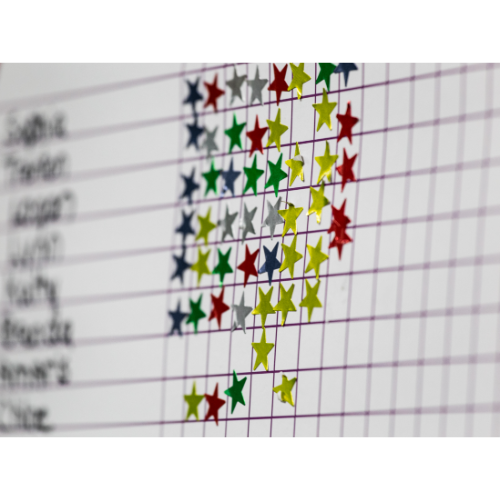Hi there!
Let’s take a look at behavior charts – those colorful, interactive tools that have become a staple in many homes and classrooms.

What is a behavior chart?
A behavior chart is a strategy that helps change or encourage a child’s behavior. There are many different types of behavior charts, ranging from simple to complex.
Do behavior charts work for children or teens with disabilities?
Yes! Behavior charts can be a super effective effective strategy for children who have many different needs, including Attention Deficit Hyperactivity Disorder (AD/HD), Autism, Learning Disabilities, or who need support with executive functioning.
Behavior charts are based on the simple principle of positive reinforcement.
By focusing on and rewarding desired behaviors, we can help children develop new habits and skills. Positive reinforcement boosts can boost children’s self-esteem and motivate them to continue practicing positive actions and behaviors.
The fun thing about behavior charts is that they provide a visual representation of progress and achievement. This makes it easier for children to track their own growth.
When children see their successes on the chart, it builds a sense of pride and encourages them to strive for further improvement (just like us adults!).
With these 5 easy steps, you can set up a behavior chart for your child or student too!

Before you start…. Set the Stage for Success
Behavior charts provide a visual representation of progress, enabling children to take ownership of their actions and strive for improvement.
Start by explaining the purpose of the chart and the rewards that await them. This not only creates anticipation but also helps establish a positive mindset from the beginning.
Step 1- Keep It Simple and Fun
The key to effective behavior charts lies in their simplicity.
Behavior charts come in various formats, such as a simple grid, a ladder, or even a themed design. Select a format that appeals to your child’s interests and age group.
Let your child decorate the chart with their favorite characters, stickers, or drawings. Personalization adds a sense of ownership and makes the chart feel special.
I’m linking a FREE printable chart for each type of chart that you can customize for your own family! You can make a copy of it via google docs, and customize it for your family!
Also, I’m a big fan of working smarter, not harder. So, if you’re like me and you buy many things off of Amazon it turns out that Amazon has many of these different types of charts already pre-made! I’m an amazon affiliate, so if you purchase these from my link, I may earn a small commission at no cost to you! I’ve linked some of my favorite types of behavior charts below.
The Star Chart:
Create a simple grid with columns for each day of the week and rows for specific behaviors or habits you want to encourage. Each time your child demonstrates the desired behavior, they earn a star. At the end of the week, count the stars and reward your child accordingly. For example, if they earn a certain number of stars, they can choose a special activity or receive a small treat.
The Superhero Chart:
Design a chart with a superhero theme, where your child can be the superhero. Divide the chart into different sections representing various tasks or behaviors. As your child completes each task or demonstrates positive behavior, they can add stickers or draw symbols representing their superhero achievements. Once they complete all the sections, they earn a superhero-themed reward, like dressing up as their favorite superhero for a day.
Possibilities are endless 🙂 Experiment with different designs and rewards to find what motivates and excites your little one the most.
Step 2- Celebrate Small Victories
One of the greatest advantages of behavior charts is their ability to break down bigger goals into smaller, achievable steps.
Celebrate each milestone along the way to keep your child motivated. Whether it’s a sticker for completing chores or a star for good manners, acknowledging their efforts will boost their self-confidence and drive them to continue doing their best.
Step 3- Customize Rewards
While behavior charts are excellent for encouraging positive behavior, the rewards associated with them should be equally enticing.
Take the time to identify what truly motivates your child. It could be a special outing, a favorite treat, or even extra playtime. Remember, personalized rewards are more likely to help motivate your child and keep them participating.
Step 4-Consistency is Key
Consistency is vital when using behavior charts. I cannot emphasize this enough 🙂
Make sure to consistently track and review progress with your child. When starting the use of the behavior chart, you will want to give stars or stickers frequently. We want to really reward the behavior that we want to see!
Once your child is more consistently demonstrating the new behavior, we can start to give the star or sticker every 2-3 times that they demonstrate the behavior. Once your little one starts demonstrating the behavior consistently, you can start to reward the behavior even less frequently. Our goal in using a behavior chart is to see behavior change, and to fade the use of the chart when we are able.
It can really help to regularly discuss the chart’s purpose and encourage open communication about any challenges that your child might face. This creates a supportive environment and helps your child or student understand that you’re on their team.
Step 5-Evolution and Adaptation
Behavior charts are not set in stone.
As your child grows, their interests and needs may change. Be flexible and open to evolving the chart to suit their evolving goals. This adaptability ensures that the chart remains a relevant and effective tool throughout their development.
Encourage self-reflection: Use the behavior chart as a tool for self-reflection and growth. Ask your child to share their thoughts on their progress, what they have learned, and how they can improve further. This self-awareness cultivates a growth mindset and fosters a sense of responsibility.

Incorporating behavior charts are powerful tools for encouraging positive habits in children.
By harnessing the potential of positive reinforcement and incorporating creativity, we can make the process enjoyable for both children and parents/educators. By keeping it simple, fun, and tailored to your child’s unique personality, behavior charts can create an atmosphere of positivity and growth.
Remember to customize the chart to suit your child’s interests, involve them in the process, and celebrate their achievements. With consistency, patience, and a touch of playfulness, behavior charts can become valuable companions on the journey of nurturing positive behaviors in our little ones.
The journey to positive behavior is a marathon, not a sprint. So, let behavior charts be your cheerleader along the way, celebrating each small victory and building a solid foundation for a brighter future. Even us adults need some motivation and rewards as we are building new habits 🙂







